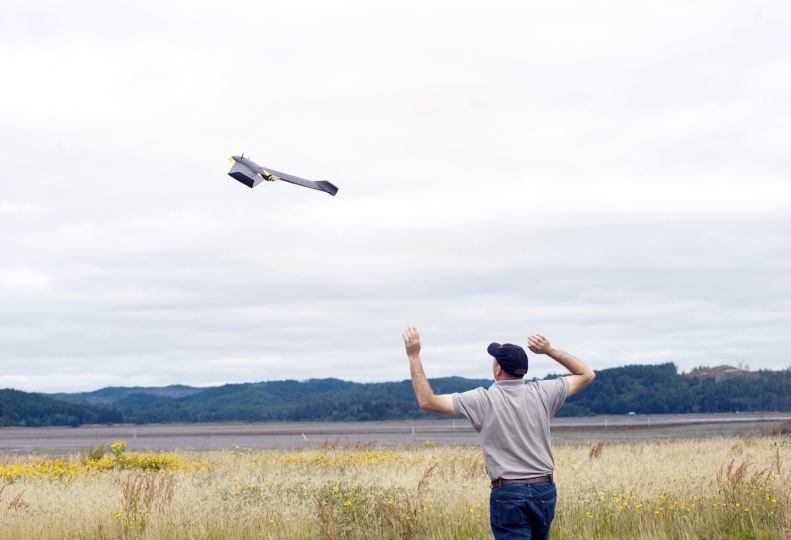
Home » Challenge after ascent
Challenge after ascent
Drone pioneer Empire Unmanned expands geographic reach as revenues level off

June 22, 2017
Following soaring sales growth in drone services reported by Hayden-based Empire Unmanned for 2016, activity this year has begun to descend as some potential customers are viewing drone operations as a do-it-yourself industry.
Bradley Ward, president of Empire Unmanned, says the company’s sales are off this year in the wake of a new set of rules the Federal Aviation Administration enacted last August. The rules eliminated an earlier requirement that all commercial drone operators must have prior experience as manned aircraft pilots.
That change cut into Empire Unmanned’s competitive edge because that company was staffed with professional pilots.
“We’re seeing some customers deciding to buy their own drones,” Ward says.
Empire Unmanned, a division of Empire Airlines Inc., formed in late 2014 and was one of the first companies authorized by the Federal Aviation Administration to use drones for commercial purposes.
The company initially focused on agricultural applications to help farmers become more efficient through its image and data-analysis services.
In agricultural applications, drones can help farmers photograph crops at any stage of growth in several light spectrums and use computer enhanced images to pinpoint crop abnormalities so they can be treated precisely.
In 2016, Empire Unmanned tripled its year-earlier sales by expanding its drone services to other private and government sectors, including mining, engineering, surveying, structural inspections, university research, and forest protection.
Sales of Empire Unmanned’s core services changed trajectory earlier this year, now that the more potential and former Empire Unmanned customers are launching their own drone operations.
“We haven’t seen growth in government contracts either,” Ward says, citing, for example, the U.S. Bureau of Land Management, which he says is sending some of its firefighting personnel to be trained to fly drones.
Empire Unmanned has maintained its staffing level at 16 employees, but is having to market to a broader geographic area beyond its original service area of Idaho, Washington, Montana, Oregon, and Utah, to keep them all working, he says.
“Now we’re marketing and taking jobs anywhere west of the Mississippi. The farthest east is in Nebraska,” he says, adding. “We’re traveling more on the front range of the Rockies—on the Colorado and Wyoming side.”
The drone industry as whole is still expanding, Ward says, and companies that build, support, and sell unmanned aircraft are growing, including those in North Idaho, such as Coeur d’Alene drone developer xCraft Enterprises LLC.
“The industry hasn’t stopped growing, but there’s more providers in the market. At this point, we’re competing on price and timing in a lot of cases,” he says. “We’re the experienced provider that knows how to do it, but the market isn’t mature enough yet to distinguish quality.”
Ward is hoping some of the newer drone service providers and operators will turn to Empire Unmanned to help them crunch the data that drones collect.
To that end, Empire Unmanned has opened up its data acquisition and delivery services to outside operators.
The services include expanded data storage capacity, processing speed, and delivery.
“We have a robust data-processing capability we built for our own use, and we’re starting to get customers for that service,” he says.
Ward, a retired Air Force pilot with extensive experience flying military drones, also is an instructor for drone operator certification classes offered through North Idaho College. He says NIC likely will schedule two courses in the fall, although he adds that he’s not yet seeing the growth he’s expecting in demand for the instruction.
Instruction and training for commercial drone operator certification also is offered in Spokane through Felts field-based Northwest Flight School.
Ward doesn’t see FAA regulations regarding commercial drones changing anytime soon.
“I think the FAA is satisfied with the regulations,” he says.
Currently, drone operators are required to keep unmanned vehicles within their lines of sight.
Empire Unmanned is using fixed-wing aircraft for 60 percent to 70 percent of its operations, with the rest involving multirotor drones.
Fixed-wing drones are best for mapping and surveying, because they can cover more acreage per flight than a multirotor drone, Ward says.
Multirotor drones are ideal for flying in tight spaces and for work that requires slower, vertical flight operations, such as structural inspections.
Latest News Up Close Technology North Idaho
Related Articles


![Brad head shot[1] web](https://www.spokanejournal.com/ext/resources/2025/03/10/thumb/Brad-Head-Shot[1]_web.jpg?1741642753)


